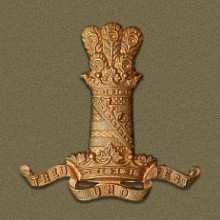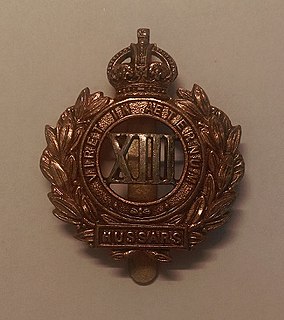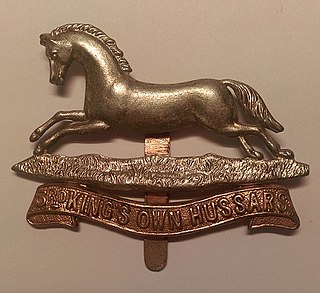William Tuyll | |
|---|---|
| Died | 10 December 1864 |
| Allegiance | |
| Service/ | |
| Rank | Colonel |
| Unit | 7th Hussars |
| Awards | Knight Grand Cross of the Royal Guelphic Order Knight of the Bath |
General Sir William Tuyll KCH (died 26 December 1864) was a British army officer.
William Tuyll | |
|---|---|
| Died | 10 December 1864 |
| Allegiance | |
| Service/ | |
| Rank | Colonel |
| Unit | 7th Hussars |
| Awards | Knight Grand Cross of the Royal Guelphic Order Knight of the Bath |
General Sir William Tuyll KCH (died 26 December 1864) was a British army officer.
Tuyll served as aide-de-camp to Lord Uxbridge during the Peninsular War, and the Walcheren Campaign in 1809. [1] He became lieutenant-colonel on half-pay of the 25th Light Dragoons in February 1812 and colonel of 7th Queen's Own Hussars in March 1846. [1] While still in this position, he died on 26 December 1864. [2]
He fought in India. He was private secretary to the Viceroy of Ireland, and one of the founders of the Oriental Club. [3] He was appointed a Knight Commander of the Royal Guelphic Order [4] and died on 26 December 1864. [2]

Dragoons were originally a class of mounted infantry, who used horses for mobility, but dismounted to fight on foot. From the early 17th century onward, dragoons were increasingly also employed as conventional cavalry and trained for combat with swords and firearms from horseback. While their use goes back to the late 16th century, dragoon regiments were established in most European armies during the 17th and early 18th centuries; they provided greater mobility than regular infantry but were far less expensive than cavalry.

The 11th Hussars was a cavalry regiment of the British Army established in 1715. It saw service for three centuries including the First World War and Second World War but then amalgamated with the 10th Royal Hussars to form the Royal Hussars in 1969.

The Queen's Royal Hussars (QRH) is a United Kingdom armoured regiment. It was formed on 1 September 1993 from the amalgamation of the Queen's Own Hussars and the Queen's Royal Irish Hussars. The regiment and its antecedents have been awarded 172 Battle Honours and eight Victoria Crosses. The regiment was based in Sennelager, Germany, until 2019 when it was relocated to Tidworth Camp, England. It is the armoured regiment for 20th Armoured Brigade Combat Team.

Lieutenant General Richard Hussey Vivian, 1st Baron Vivian, known as Sir Hussey Vivian from 1815 to 1828 and Sir Hussey Vivian, Bt, from 1828 to 1841, was a British cavalry leader from the Vivian family.
General James Alexander St Clair-Erskine, 3rd Earl of Rosslyn PC, DL, styled Lord Loughborough from 1805 to 1837, was a Scottish soldier and Tory politician. A General in the British Army, he also held political office as Master of the Buckhounds between 1841 and 1846 and again in 1852 and as Under-Secretary of State for War in 1859.

The 10th Royal Hussars was a cavalry regiment of the British Army raised in 1715. It saw service for three centuries including the First World War and Second World War but then amalgamated with the 11th Hussars to form the Royal Hussars in October 1969.

The 13th Hussars was a cavalry regiment of the British Army established in 1715. It saw service for three centuries including the Napoleonic Wars, the Crimean War and the First World War but then amalgamated with the 18th Royal Hussars, to form the 13th/18th Royal Hussars in 1922.
Cobb's Legion was an American Civil War unit that was raised on the Confederate side from the State of Georgia by Thomas Reade Rootes Cobb during the summer of 1861. A "legion" consisted of a single integrated command, with individual components from the infantry, cavalry, and artillery. When it was originally raised, the Georgia Legion comprised seven infantry companies, four cavalry troops, and a single battery. The concept of a multiple-branch unit was fine in theory, but never was a practical application for Civil War armies and, early in the war, the individual elements were assigned to other organizations.

The Battle of Sahagún was a cavalry clash at Sahagún, Spain, in which the British 15th Light Dragoons (Hussars) defeated two regiments of French cavalry during the Corunna Campaign of the Peninsular War. Losses to one of the French regiments were so heavy that it was subsequently disbanded. The action marked the final phase of the British army's advance into the interior of Spain, before they began their harrowing retreat to the coast and ultimate evacuation by sea.

The 14th King's Hussars was a cavalry regiment in the British Army, first raised in 1715. It saw service for two centuries, including the First World War, before being amalgamated with the 20th Hussars to form the 14th/20th King's Hussars in 1922.

The 18th Royal Hussars was a cavalry regiment of the British Army, first formed in 1759. It saw service for two centuries, including the First World War before being amalgamated with the 13th Hussars to form the 13th/18th Royal Hussars in 1922.

The 3rd Hussars was a cavalry regiment of the British Army, first raised in 1685. It saw service for three centuries, including the First World War and the Second World War, before being amalgamated with the 7th Queen's Own Hussars, to form the Queen's Own Hussars in November 1958.

The 4th Queen's Own Hussars was a cavalry regiment in the British Army, first raised in 1685. It saw service for three centuries, including the First World War and the Second World War. It amalgamated with the 8th King's Royal Irish Hussars, to form the Queen's Royal Irish Hussars in 1958.

The 8th King's Royal Irish Hussars was a cavalry regiment in the British Army, first raised in 1693. It saw service for three centuries including the First and Second World Wars. The regiment survived the immediate post-war reduction in forces, and went on to distinguish itself in the battles of the Korean War, but was recommended for amalgamation in the 1957 Defence White Paper prepared by Duncan Sandys. The regiment was amalgamated with the 4th Queen's Own Hussars, to form the Queen's Royal Irish Hussars in 1958.

The 15th The King's Hussars was a cavalry regiment in the British Army. First raised in 1759, it saw service over two centuries, including the First World War, before being amalgamated with the 19th Royal Hussars into the 15th/19th The King's Royal Hussars in 1922.

The 7th Queen's Own Hussars was a cavalry regiment in the British Army, first formed in 1689. It saw service for three centuries, including the First World War and the Second World War. The regiment survived the immediate post-war reduction in forces, but following the 1957 Defence White Paper, it was amalgamated with the 3rd The King's Own Hussars, forming the Queen's Own Hussars in 1958.

The regimental depot of a regiment is its home base for recruiting and training. It is also where soldiers and officers awaiting discharge or postings are based and where injured soldiers return to full fitness after discharge from hospital before returning to full duty. Normally, a variety of regimental stores will also be kept at the depot. The regimental depot is not the same as the regimental headquarters, though in practice the two will often be co-located in the same place.
Colonel Charles Hagart CB was a British Army officer.
General William Hampton Parlby was a senior British Army officer, who served in British cavalry regiments in India and the Crimean War.
General William Neville Custance was a senior British Army officer, who served initially as an infantry officer; but mainly as cavalry officer. Seeing service in the Crimean War and the Indian Rebellion of 1857.